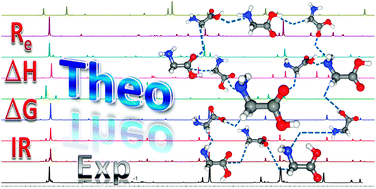Accurate structure, thermodynamic and spectroscopic parameters from CC and CC/DFT schemes: the challenge of the conformational equilibrium in glycine†
Abstract
The structures, relative stabilities, and infrared spectra of the six low-energy conformers of glycine have been characterized using a state-of-the-art quantum-mechanical approach allowing the bond distances, conformational enthalpies and vibrational frequencies to be determined well within the chemical accuracy. Transition state structures governing interconversion among the different energy minima have also been characterized. In detail, the gas-phase thermodynamic properties (at 15 K and 410 K) of the glycine conformers considered have been obtained with a 1 kJ mol−1 accuracy, and it has been shown that the employment of DFT geometries usually reduces such accuracy by at most 0.1 kJ mol−1. Regarding molecular structures, the use of two different composite schemes allowed us to further confirm the suitability of a rather cost-effective approach and provide geometrical parameters with an overall accuracy better than 0.002 Å for distances and 1 degree for angles. Thanks to a hybrid CC/DFT approach, the infrared spectra of all conformers considered and of several deuterated isotopologues have been reproduced (when experimental data were available) or predicted with an accuracy of 10 cm−1. Finally, the joint thermodynamic and spectroscopic investigation allowed us to shed some light on the possible observation of elusive conformers. On the whole, the high accuracy of the computational results allows us to draw a fully consistent interpretation of the available experimental data and to obtain a more complete characterization of the potential energy surface of glycine.

- This article is part of the themed collection: Spectroscopy and dynamics of medium-sized molecules and clusters

 Please wait while we load your content...
Please wait while we load your content...